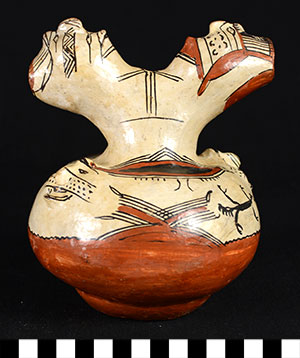Festival Drinking Vessel: Unaimanda, Two-Headed Effigy
1997.15.0132
Detailed Images
Basic Information
| Artifact Identification | Festival Drinking Vessel: Unaimanda, Two-Headed Effigy (1997.15.0132) |
|---|---|
| Classification/ Nomenclature |
|
| Artist/Maker | Alicia Canelos |
| Geographic Location | |
| Period | N/A |
| Date | 1972 - 1973 |
| Culture | Canelos Quichua |
| Location | Not on Exhibit |
Physical Analysis
| Dimension 1 (Height) | 17.9 cm |
|---|---|
| Dimension 2 (Width) | 15.0 cm |
| Dimension 3 (Depth) | 14.6 cm |
| Weight | 525 g |
| Measuring Remarks | Under Review |
| Materials | Ceramic--Stoneware, Pigment |
| Manufacturing Processes | Handbuilding, Firing, Painting, Rubbing |
Research Remarks
| Description | N/A |
|---|---|
| Published Description | Under Review |
| Bibliography | Whitten, Norman and Dorothea. From Myth to Creation: Art from Amazonian Ecuador. Champaign: University of Illinois Press, 1988. P. 30. |
Artifact History
| Credit Line/Dedication | Gift of Norman E. and Dorothea S. Whitten |
|---|---|
| Reproduction | No |
Contact
All information about our collection is constantly reviewed and updated. Please contact Dery Martínez-Bonilla, Registrar, if there is any information you are looking for that isn't currently online.
